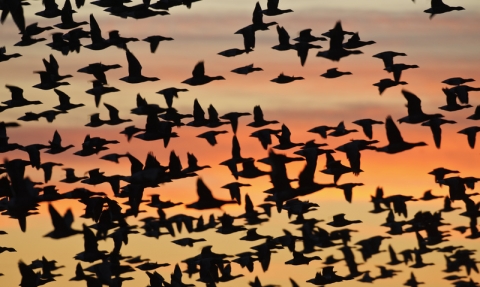
Brent Geese © Terry Whittaker/2020VISION
Top wildlife experiences
Whether it's the height of summer or the chilly winter, nature always has something going on that will enrich our lives.
With the wealth of landscapes and habitats that we are lucky to have across our two counties, there are many magical spectacles and experiences to be had right on our doorsteps.
Find out more about our highlights all year round:
January
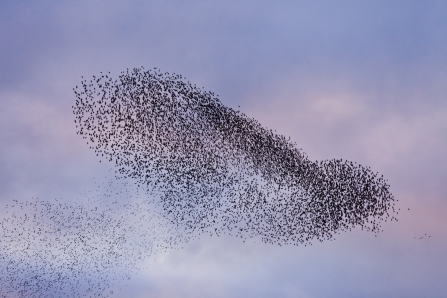
© Guy Edwardes/2020VISION
January Wildlife Experiences
Winter evenings offer a daily dusk spectacle as birds flock together to roost for the night.
Starling murmurations are widely admired for their acrobatic and mesmerising displays; but they’re not the only species to gather in large numbers in the evenings. Winter displays at Blashford Lakes often include thousands of gulls, geese and goosander using the lakes as a safe resting and refuge after dark.
A visit to the reserve at dusk is a must, with the ever increasing gull roosts and the gathering starlings swirling in murmuration against the clear skies.
How to do it:
Blashford Lakes offers a great place to watch the spectacle, with up to 20,000 gulls, 500 geese and 200 goosander come in to roost on Ibsley Water in the evenings.
February
© David Phillips
February Wildlife Experiences
Late winter is an ideal time to catch up with the wintering wildfowl and waders visiting from the north and east
Our winter migrants are out and active on our coasts, after being attracted here by the ice free waters, saltmarshes and mudflats.
Protected stretches of our coast offer a mix of habitats for ducks like wigeon, teal, pintail, and shoveler - 'dabblers' snatch food from the sea's surface, while 'divers' venture deeper down.
At low tide you can find waders like dunlins, sanderlings, and oystercatchers dipping into the waves and digging in the mud in search of plants, insects, worms, and crustaceans.
How to do it
Time your visit for an hour or so before high tide, and you’ll be there to see the birds pushed up off the mud by the incoming water. At high tide roost sites, thousands of birds gather together, jostling for space on what remains of the higher ground. The spring tides are the highest of the year, so will normally result in the biggest performances by the flocks.
Find a coastal path, such as the one at Lymington and Keyhaven and grab a pair of binoculars. Choose a few easy species to look out for, like the striking black and white avocet or the curlew with its unmistakable long bill.
Many of our coastal birds are winter visitors, and use their time on our shores to rest and feed before the long migration home. When disturbed they use up precious energy, but there are easy steps you can take to help avoid this - Bird Aware Solent have lots of excellent advice.
Other February wildlife experiences
|
|
March
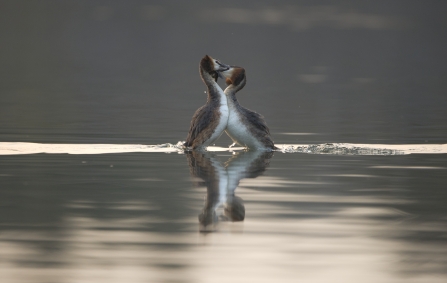
© Andrew Parkinson/2020VISION
March Wildlife Experiences
These slinky water birds are famous for their wonderful courtship dance, a ritual fit for ‘Strictly’.
As mists rise from the water’s surface on early spring mornings, great crested grebe pairs join together to dance. With orange and black head plumes spread wide, an elegant ritual of head shaking, bill-dipping and preening culminates in the famous ‘penguin dance’.
The pair rush together, paddling their feet frantically to raise upright from the water. Standing chest to chest, they flick a beak-full of water weed at each other before one final shake of the head and the weed is dropped, and the deal is clinched.
How to do it:
Find a filled gravel pit, lake or canal where a pair of great crested grebes are residing, such as Testwood Lakes, and try your luck. All you need is a pair of binoculars and a little patience… although a flask of hot chocolate is handy too.
If you’re lucky enough to see that final penguin dance, then come back in five weeks’ time and you should be able to see their stripy ‘humbug’ babies riding on their parents’ back.
Other March wildlife experiences
April
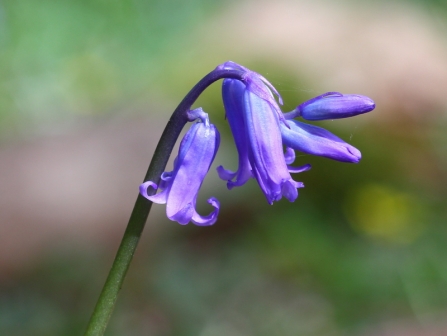
© Bob Chapman
April Wildlife Experiences
As spring gets into its stride, bluebells burst into colour in our ancient woodlands.
Around mid to late April is the ideal time to catch bluebells in full bloom creating one of our most breathtaking natural spectacles.
Woodland rides, where bluebell bulbs have lain dormant for months, are lit up with sapphire as they race to flower before the other woodland plants, and take advantage of the sun streaming through leafless trees above.
The UK is home to more than half the world’s population of Hyacinthoides non-scripta, making the bluebell our unofficial national flower, and their presence is a sure sign of very old woodland.
How to do it:
Do a little research to find out where your nearest ancient woodland is, then pick a sunny day, when the dappled light will be at its best, and head into the woods. And while you’re there, remember it’s not just about the colour. The flowers have a distinctive if subtle sweet scent: get down amongst the nodding flower heads and take a deep sniff.
Other April wildlife experiences
May
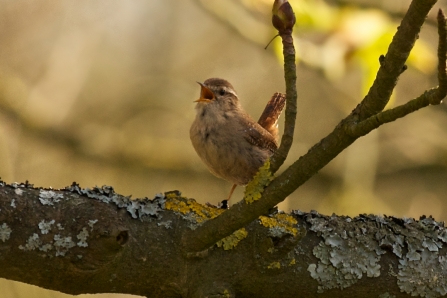
Wren © Steve Page
May Wildlife Experiences
Get up bright and early to catch our feathered friends in full song
Spring is the best time to listen out for the beautiful phenomenon of the dawn chorus. It does mean an early start – with birds waking up and raising their voices just before, during and just after sunrise. However different birds pipe up as the morning progresses as they compete for mates, making it a real treat.
How to do it
Find somewhere that’s relatively quiet and home to lots of woodland birds. Ideal days for the chorus are those with the best weather.
As well as being more comfortable for you the audience, dry clear and calm mornings mean you’ll be able to hear the performers better.
The first birds begin to sing about an hour before sunrise, when they're least likely to be spotted by predators.
Other May wildlife experiences
June
© Mark Heighes
June Wildlife Experiences
Enter a bewitching world of men and monkeys, ladies and lizards, frogs and flies – our summer orchids.
Summer is a time for wild flower meadows - hillsides ablaze with colour and a-buzz with insects. The superstars of the wild flower world are the orchids, and now is the best time to go out and enjoy their glamorous allure.
Of the fifty or so species that are native to the UK, some are surprisingly common and widespread, while others are our most elusive rarities, found only in a select handful of special places.
The beautiful bee orchid, whose flower famously mimics a furry-bodied bee to fool its pollinator, is actually amongst the more common species, often turning up on road verges as well as grasslands and open ground around gravel pits. It’s more understated cousin, the fly orchid pulls off a similar trick on the edge of woodland.
How to do it:
Search online for where you can visit wildflower meadows – nature reserves like Noar Hill, St Catherine’s Hill, and Ron Ward's Meadow are good places to start.
Be very careful where you tread - as well as the obvious flower spikes, there will be plenty of non-flowering leaf rosettes which you should avoid trampling.
Tempting as it may be, don’t pick the flowers. Orchids look their best out in the wild, and some species are legally protected: you could be breaking the law.
Other June wildlife experiences
July
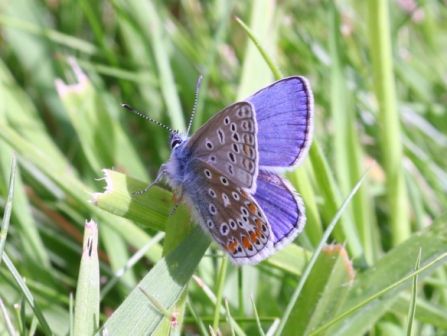
July Wildlife Experiences
See if you can tell the difference between a chalk hill and an Adonis blue butterfly.
Among our butterflies, one group best sums up those hot days of high summer. On a south-facing downland slope, bright blue butterflies skip and chase across the hillside.
The large blue is a very rare beast, only found on a tiny handful of sites where it has been reintroduced, and the small blue flies earlier in the year, but the other five ‘blues’ are all on the wing in the summer holidays.
It’s on the grasslands that the blues really come into their own. The familiar common blue, the large powder-blue chalk hill and the dazzlingly azure Adonis blue butterfly can be seen on the wing together, and in the best years on the best sites, the numbers really can be staggering.
How to do it:
Butterflies are at their best on a still, sunny day. Wind and rain are not the butterfly watcher’s friend. So sit back on that sunny hillside and watch as a cloud of blue butterflies tumbles around you. Reserves like Arreton Down on the Isle of Wight offer a spectacular spot to play the blues.
Other July wildlife experiences
August
© Amy Marden
August Wildlife Experiences
Admire the weird and wonderful wildlife normally hidden under our waves.
All you need to go rockpooling is a tray and some gentle hands. Ledges and pools often provide good hiding places for coastal wildlife – but even flat beaches have lots to offer – look out for scuttling crabs, bouncy sandhoppers, and slippery seaweed.
How to do it
Visit and explore your local beach, or a coastal nature reserve like Milton Locks, Farlington Marshes, or Bouldnor Forest.
Alternatively, check out what's on for our marine project Secrets of the Solent, including shore surveys and activities for National Marine Week.
When you're out on the coast, remember to take care around our marine wildlife. Avoid handling delicate animals, watch where you're walking, and put anything you move back where you found it.
Other August wildlife experiences
September
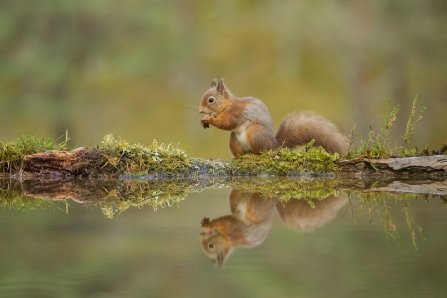
Red Squirrel © Mark Hamblin
September Wildlife Experiences
Red squirrels are at their most visible during the autumn as they forage for and stash nuts
Once a common animal across the country, the red squirrel has disappeared from great swathes of the country. The Isle of Wight is one of only two places in England where there are no grey squirrels to out-compete their cousins, meaning reds are flourishing. With distinctive russet fur, tufted ears and twitching tail, a native red squirrel is a captivating sight.
How to do it:
Like most wild animals, red squirrels tend to be shy of people - so keep as quiet as you can.
A good first place to look is on bird feeders! Red squirrels are just as keen on peanuts as their grey cousins, and they may come to feeders if they are available. A good bet is to visit Bouldnor Forest nature reserve on the Isle of Wight, where red squirrels still thrive.
Other September wildlife experiences
October
Fly Agaric @ Hayley Muir
October Wildlife Experiences
Once you start searching for fungi you will soon find that the forest floor is an alien landscape where anything goes.
When we think of a fungus, the first thing that springs to mind is the traditional red and white fly agaric toodstool - but when you start looking, there’s seemingly no limit to the variety of shapes, textures and colours that you’ll see.
Yellow brain fungus springs up from dead twigs of deciduous trees; shaggy inkcaps become bell-shaped, darken in colour and melt away; and stinkhorns generate a ‘rotting flesh’ smell to attract flies.
How to do it
Arm yourself with a fungi spotter sheet, and see what fantastic fungi you can find on in woodland like that at Pamber Forest nature reserve. Get down low, and look out for dead trees, which often spring new life in the form of fungi.
Just like wildflowers, fungi are an important part of the woodland ecosystem, so are best left where they are for wildlife and other people to enjoy.
Other October wildlife experiences
November
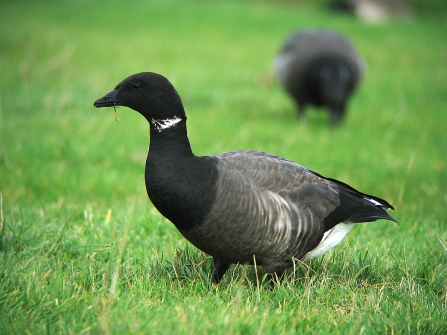
© Jason Crook
November Wildlife Experiences
Dark-bellied brent geese gather after arriving from their long flight from the Arctic.
In autumn we see the arrival of some 30,000 brent geese from Siberia to spend the winter feeding on eel grass and grazing in coastal fields. Their dangerous journey takes them along the Northern European coastline, across frozen land, through gale force winds, and over stormy seas.
The annual round trip means a single goose can fly over 135,000 miles in its lifetime between its winter and summer homes.
How to do it
Wrap up warm and head to one of the geese’s favoured coastal haunts, such as Farlington Marshes or Lymington and Keyhaven Marshes nature reserves, with a pair of binoculars. Brent geese are fairly distinctive, with their dark heads and bellies, and white tails.
With a long migration home ahead of them, the brent geese visiting our shores need plenty of food and rest during the winter months. Take care to admire without disturbing them, following the advice in Bird Aware Solent's Coastal Code.
Other November wildlife experiences
December
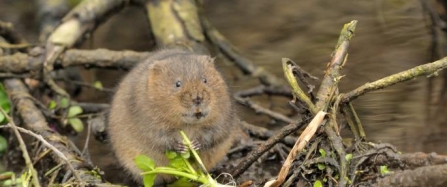
Water Vole by Russ Valentine
December Wildlife Experiences
Head to the riverbank to track down one of our most endangered and much-loved mammals, the water vole.
Better known as ‘Ratty’ in The Wind in the Willows, the water vole was once a common resident of rivers, streams, ditches, ponds, lakes and other wet places.
Numbers dwindled after the introduction of mink and loss of habitat, and water voles have now disappeared from many former haunts. Thanks to the heroic efforts of many volunteers and Wildlife Trusts, water voles are making a comeback in some areas.
Be patient and you might see them foraging on the bank or hear the distinctive ‘plop’ of one dropping into the water.
How to do it
Visit a wildlife haven with a river, like Winnall Moors, and get settled. As well as looking for the animal itself, you should also try looking for the tracks and signs of water voles. Burrows with grazed ‘lawns’ at their entrance, piles of nibbled stems and distinctive latrines are sure signs of water voles in the area. As always, take care near the water’s edge.
Other December wildlife experiences
|
|
Share your Top Wildlife Experiences
These are just our ideas for exciting wild experiences here in Hampshire and the Isle of Wight - but we want to hear from you what adventures you've had. What's your favourite wildlife experience - and what special moments have you had along the way?
Share your ideas online using #lovewildlife.
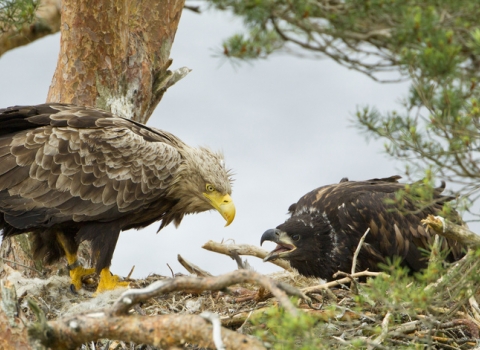
© Mark Hamblin/2020VISION
Top wildlife experiences around the UK
These are a selection of local wildlife experiences - visit The Wildlife Trust's UK-wide guide to top wildlife experiences for those that are a little further afield.
